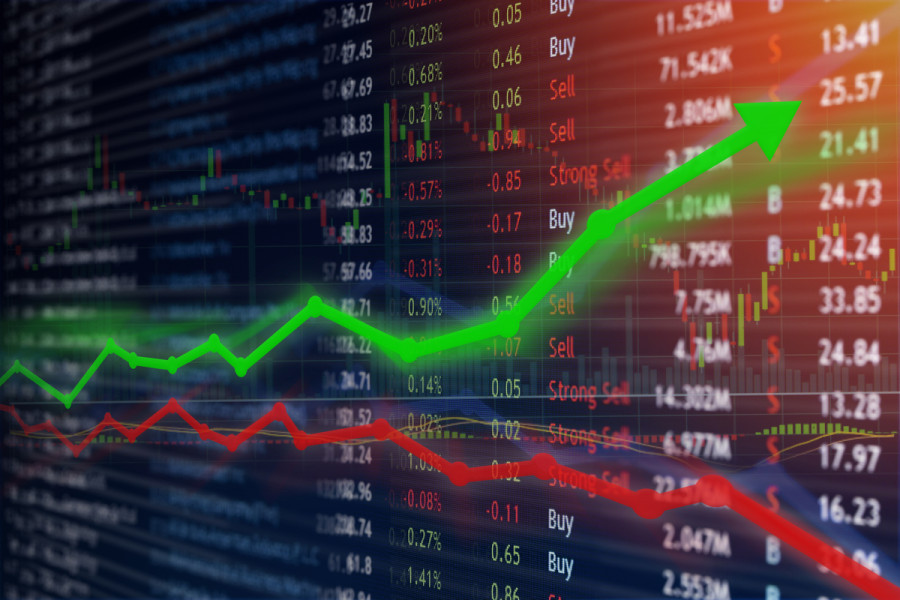Columns
Fear driving post-bubble NEPSE
If the economy does well, and the intrinsic value of companies rises, stocks will follow.
Paban Raj Pandey
No one said investing was going to be easy. It never has been and will never be. Assets have always been ruled by the cycle of greed and fear. From the Dutch tulip mania in the 1630s to the froth leading to the August 2021 peak in the Nepal Stock Exchange (NEPSE), bubbles are sustained so long as a greater fool is willing to pay a higher price. Once this speculation ends and the music stops, the air emerges from the balloon. On the other side of the spectrum, as opposed to the “fear of missing out” dominating action on the way up, the fear of getting stuck with an investment no one wants drives sentiment on the way down. At/near the bottom, pessimism runs very high; buyers are hard to come by.
On the way to printing the record high of 3,227 in August 2021, the NEPSE had a phenomenal time lasting well over two years, with the index bottoming at 1,099 in March 2019. Valuations had nearly tripled during that time. At the peak, Nepal’s sole exchange was valued at a market capitalisation of just under Rs4.3 trillion, even as the daily turnover hit a record Rs21.6 billion on the 15th. For comparison, the current market cap is just south of Rs3 trillion, and the daily turnover is just north of Rs1 billion. After the bubble burst, the NEPSE collapsed 44 percent through 1,807 on June 24 last year. Subsequently, 1,800 has attracted bids thrice—in September last year and May and November this year.
The Bulls’ problem is that they are struggling to build on any upside momentum. Since the June 2022 low, the NEPSE has rallied past 2,200 thrice—in August last year and January and July this year—but only to meet with selling. This is what a bear market does. Holders are driven to maximum frustration, making them want to puke and yell ‘get me out’. Greed plays hooky, while fear is pervasive. Even as jittery buyers remain on strike, contrarians begin to dip their toes in, but they do not always get the timing right. All this is part of a bottoming process. The NEPSE is probably in the middle of one. Since it is at the bottom of its 400-point range, a rally to the range top—or at least 2,000—is the path of least resistance.
Stocks don’t always soar
If, however, 1,800 is decisively breached, this is the markets’ way of saying the economy has deeper problems and that more pain lies ahead. And there will be calls for action. The finance minister and the governor will be blamed for sitting on their hands and doing nothing to ease investors’ pain. In fact, this is happening as we speak. After coming under huge—and undue—pressure to revise its margin policy instituted by the 2021-22 monetary policy, the central bank in early October raised the ceiling individual and institutional investors could borrow to Rs150 million and Rs200 million, respectively, from the existing Rs120 million. Investors demanding a repeal of the policy were unhappy and drove the NEPSE down.
The Nepal Rastra Bank has been widely criticised for inducing the NEPSE peak in August 2021. The 2021-22 monetary policy limiting margin loan per customer to Rs40 million at one bank and Rs120 million at multiple banks was announced in July that year. Speculation was rampant back then. To give credit where it is due, the central bank was right to tighten lending. Given the complacent environment, market participants should have known this was a growing risk given the complacent environment. Then again, considering the short investing history in Nepal, many probably were not and simply got carried away. Many probably bought near the peak, did not get out on time and are now sitting on loads of losses. They are clearly not happy.
These people should accept this as a lesson—a lesson hard learned—that markets do not always go up. There are ups, and there are downs. Investing 101! The temptation to make quick bucks is irresistible—particularly when everyone to your left and right is minting money in a bull market—but it is also a fact that price trends can reverse in minutes, which is when buying decisions done more on emotion than on independent analysis pay the price. In fact, this phenomenon holds true everywhere—in emerging markets like Nepal and developed ones alike. No one complains when markets are rising—no matter how hyped-up. But when the chips are down, immature markets tend to quickly look for scapegoats.
Be greedy for growth
This is so evident in Nepal currently. No sooner did the bulls realise that the NEPSE had peaked than the blame game began. From hunger strikes to demands for resignations from officials, including the Nepal Rastra Bank governor, attempts were made to pressure the regulator into scrapping the margin policy. Even finance ministers—past and present—tried to influence the central bank’s decision-making process. They all fell on deaf ears—rightly so. In the long run, abrupt regulatory changes designed to please the crowd tend to damage sentiment, as markets can lose faith in the policy-making body. Despite this, regulators—in emerging and developed markets as well—commit this mistake.
In the United States, as the great financial crisis unfolded, stocks began to unravel in October 2007. To prevent further decline, short selling of financial stocks was banned in September 2008, but this did not stop the carnage. Later, Securities and Exchange Commission officials were quoted as saying the net result of banning short sales was harmful. More recently, China last month asked its banks to lend billions to stabilise the struggling real estate sector, which accounts for more than 20 percent of the gross domestic product. After heady growth that lasted years, home sales are falling, and default risks for developers are rising. For a year now, support measures have not yielded the desired results.
The point in all this is that conjuring up a populist policy is easy, but getting to the root of the problem is not. Ironically, it is not the job of regulators to haphazardly support asset prices or wish for higher prices. Their job is to regulate in a way that a sound investing environment is instituted—the same way policymakers’ job is to provide the right conditions for a durable economy. The best remedy to counter a bear market, which has a life of its own, is growth. If the economy does well, and companies’ intrinsic value rises, stocks will follow. This is what should drive the policymakers, who need to show the right kind of greed—greed for growth. This will propel the stock market for decades to come.




 9.12°C Kathmandu
9.12°C Kathmandu















